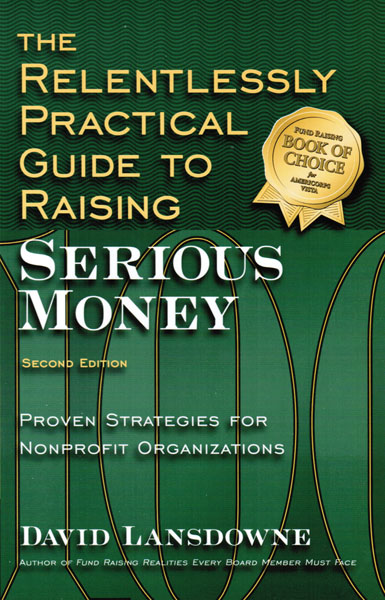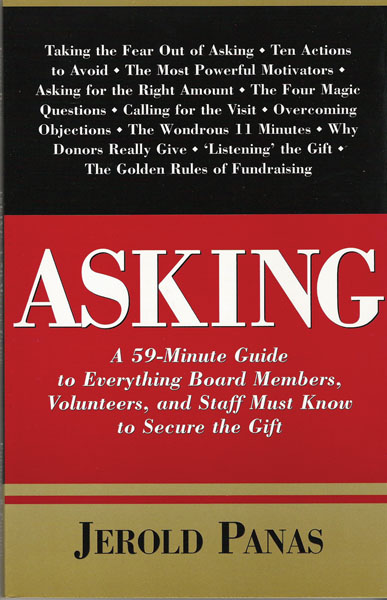 |
| The Relentlessly Practical Guide to Raising Serious Money: Proven Strategies for Nonprofit Organizations; 2nd ed., by David Landsdowne (Emerson & Church, 2008, 237 pp., $24.95 |
For nonprofits today, the competition for donor dollars is intense. Affluent donors can see the requests coming from a mile away — every alma mater from elementary school through graduate school, not to mention the church, the hospital, and special causes dear to one's heart. Where does this leave seminary fundraisers? With a lot of company.
The Relentlessly Practical Guide to Raising Serious Money, by David Lansdowne, offers a basic road map for raising money not just for theological schools, but for all nonprofit organizations. Lansdowne walks the reader through a series of checklists, anecdotes, and step-by-step directions for everything from capital campaigns and direct mail to foundations and major gifts.
The book begins with 16 bits of fundraising advice that seem simplistic but can serve as a foundation for people who are new to this field. Although this book is not exactly new — it was originally written in 2004 and updated in 2008 — the advice is current and creative, given in bite-sized portions. But a word of warning is needed: The Relentlessly Practical Guide does not address online giving as thoroughly as more recent publications do.
One of the most important chapters is the very last — fundraising's 20 biggest and costliest mistakes. Read this chapter first, since you can learn much by knowing what to avoid.
Some of the most important pitfalls that Lansdowne identifies:
■ Thinking your organization will attract support because yours a good cause.
■ Believing that because people are wealthy, they will contribute to you.
■ Failing to research and evaluate prospects.
■ Failing to ask.
■ Failing to cultivate donors.
■ Failing to see your top prospects in person.
■ Thinking you can whisk wealthy prospects in at the last minute.
■ Failing to recruit the right trustees.
■ Failing to find the right person to ask.
Each "mistake" is followed by a brief scenario explaining the issue, but it's also possible to return to earlier places in the text to find much more information.
The appendix includes two sections: "fundraising myths" and "what board members must know to succeed." Lansdowne has a long list of maxims (48!) written specifically with board members in mind, but he starts with the golden rule: Board members need to embrace the notion that "fundraising is the board's responsibility." If we can get boards to internalize just that one maxim, we're ahead of the game.
I would recommend this appendix as a handout for new and existing board members − especially in schools that are laying the groundwork for a campaign. But most board members won't be interested in reading the whole book.
The Relentlessly Practical Guide is strong on fundamentals, with checklists in all the key areas, but it's fairly basic. While there is not anything specific about raising money for theological education, the principles apply everywhere — from the elementary school on up.
The Relentlessly Practical Guide to Raising Serious Money: Proven Strategies for Nonprofit Organizations, 2nd ed., by David Lansdowne (Emerson & Church, 2008, 237 pp., $24.95).
Now you're really asking for it
 |
| Asking: A 59-Minute Guide to Everything Board Members, Volunteers, and Staff Must Know to Secure the Gift, by Jerold Panas (Emerson & Church, 2002, 108 pp., $24.95) |
Why do many fundraisers fail to secure the major gift? Because they don't ask!
Like fishermen, most people who raise money can point to "the one that got away." But for fundraisers, it's usually not
because we yanked the line too hard, but because we never started reeling in. Sometimes the ask is made at the wrong time. Sometimes it's made by the wrong person. And sometimes it's just done the wrong way.
Asking: A 59-Minute Guide to Everything Board Members, Volunteers, and Staff Must Know to Secure the Gift, by Jerold Panas, lives up to its title. Practical and funny, it's an excellent primer for board members and other volunteers who are full of dedication to the mission but who lack the practical experience of actually asking for a gift.
Panas focuses on the most positive aspects of involvement in a campaign. Borrowing from George Bernard Shaw, he says that volunteers are undertaking "the joy of being used for a purpose recognized by all as a mighty one." The book is written directly to the novice asker — "Your task is vital because without your help your organization couldn't exist," he says. "It couldn't balance its budget, provide its services, couldn't build the buildings. You make it possible."
Very early on, the author lets readers off the hook — don't expect to be 100 percent successful, he says, because you won't be. Since fear of failure often keeps good people on the sidelines, he emphasizes that there's no such thing as an incorrect ask. Indeed, some prospects will keep their wallets closed no matter how dazzling the presentation, while others will give, but less generously than you had hoped. At times like this, disappointment is normal, but Panas reminds readers that there's always a chance to be better prepared next time.
The book is filled with specific recommendations. There are suggestions about language — when you call to arrange a meeting, ask to "visit" but avoid calling it an "appointment," since a visit is enjoyable but everyone wants to avoid more appointments. There are also letters and scripts that, with minor editing, can be used by a seminary or, indeed, by almost any organization. The language that Panas recommends is geared for the volunteer asker: "You know how involved I am with the Salvation Army. I want to bring you up to date on some things we're doing. I'm certain you'll find it exciting. Is Tuesday or Wednesday of next week the better day for us to get together?"
The book concludes with the following rule of success:
The right person
asks
the right prospect
for
the right amount
in
the right way
at
the right time
for
the right cause
with
the right follow-up
and you ⇒ you are the right person.
This book is worth giving to every board member and volunteer on your team, and maybe even to those whom you hope will join the team. It's a warm and funny approach to the important work that we must do to keep our institutions healthy.
Asking: A 59-Minute Guide to Everything Board Members, Volunteers, and Staff Must Know to Secure the Gift, by Jerold Panas (Emerson & Curch, 2002, 108 pp., $24.95).